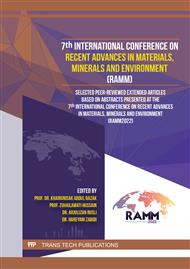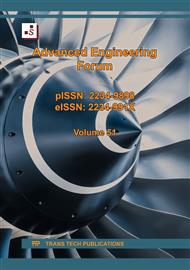[1]
F. Topuz and T. Uyar, "Electrospinning of gelatin with tunable fiber morphology from round to flat/ribbon," Mater. Sci. Eng. C, vol. 80, p.371–378, 2017.
DOI: 10.1016/j.msec.2017.06.001
Google Scholar
[2]
G.R. Williams, B.T. Raimi-Abraham, and C.J. Luo, "Electrospinning fundamentals," Nanofibres Drug Deliv., p.24–59, 2018.
DOI: 10.2307/j.ctv550dd1.6
Google Scholar
[3]
R. Ghobeira, M. Asadian, C. Vercruysse, H. Declercq, N. De Geyter, and R. Morent, "Wide-ranging diameter scale of random and highly aligned PCL fibers electrospun using controlled working parameters," Polymer (Guildf)., vol. 157, no. October, p.19–31, 2018.
DOI: 10.1016/j.polymer.2018.10.022
Google Scholar
[4]
R. Khajavi and M. Abbasipour, Controlling nanofiber morphology by the electrospinning process, no. 2. Elsevier Ltd., 2017.
DOI: 10.1016/b978-0-08-100907-9.00005-2
Google Scholar
[5]
S. Thenmozhi, N. Dharmaraj, K. Kadirvelu, and H. Y. Kim, "Electrospun nanofibers: New generation materials for advanced applications," Mater. Sci. Eng. B Solid-State Mater. Adv. Technol., vol. 217, p.36–48, 2017.
DOI: 10.1016/j.mseb.2017.01.001
Google Scholar
[6]
M. Rahmati, D. K. Mills, A. M. Urbanska, M. R. Saeb, J. R. Venugopal, S. Ramakrishna, and M. Mozafari, "Electrospinning for tissue engineering applications," Prog. Mater. Sci., p.100721, 2020.
DOI: 10.1016/j.pmatsci.2020.100721
Google Scholar
[7]
P. H. Kim and J. Y. Cho, "Myocardial tissue engineering using electrospun nanofiber composites," BMB Rep., vol. 49, no. 1, p.26–36, 2016, doi:10.5483/BMBRep. 2016.49.1.165.
DOI: 10.5483/bmbrep.2016.49.1.165
Google Scholar
[8]
T. C. Suh, A. Y. Amanah, and J. M. Gluck, "Electrospun scaffolds and induced pluripotent stem cell-derived cardiomyocytes for cardiac tissue engineering applications," Bioengineering, vol. 7, no. 3, p.1–22, 2020.
DOI: 10.3390/bioengineering7030105
Google Scholar
[9]
L. A. Can-Herrera, A. I. Oliva, M. A. A. Dzul-Cervantes, O. F. Pacheco-Salazar, and J. M. Cervantes-Uc, "Morphological and mechanical properties of electrospun polycaprolactone scaffolds: Effect of applied voltage," Polymers (Basel)., vol. 13, no. 4, p.1–16, 2021.
DOI: 10.3390/polym13040662
Google Scholar
[10]
B. Tarus, N. Fadel, A. Al-Oufy, and M. El-Messiry, "Effect of polymer concentration on the morphology and mechanical characteristics of electrospun cellulose acetate and poly (vinyl chloride) nanofiber mats," Alexandria Eng. J., vol. 55, no. 3, p.2975–2984, 2016.
DOI: 10.1016/j.aej.2016.04.025
Google Scholar
[11]
J. Lasprilla-Botero, M. Álvarez-Láinez, and J. M. Lagaron, "The influence of electrospinning parameters and solvent selection on the morphology and diameter of polyimide nanofibers," Mater. Today Commun., vol. 14, no. December 2017, p.1–9, 2018.
DOI: 10.1016/j.mtcomm.2017.12.003
Google Scholar
[12]
A. Haider, S. Haider, and I. K. Kang, "A comprehensive review summarizing the effect of electrospinning parameters and potential applications of nanofibers in biomedical and biotechnology," Arab. J. Chem., vol. 11, no. 8, p.1165–1188, 2018.
DOI: 10.1016/j.arabjc.2015.11.015
Google Scholar
[13]
K. A. G. Katsogiannis, G. T. Vladisavljević, and S. Georgiadou, "Porous electrospun polycaprolactone fibers: Effect of process parameters," J. Polym. Sci. Part B Polym. Phys., vol. 54, no. 18, p.1878–1888, 2016.
DOI: 10.1002/polb.24090
Google Scholar
[14]
Z. Asvar, E. Mirzaei, N. Azarpira, B. Geramizadeh, and M. Fadaie, "Evaluation of electrospinning parameters on the tensile strength and suture retention strength of polycaprolactone nanofibrous scaffolds through surface response methodology," J. Mech. Behav. Biomed. Mater., vol. 75, no. August, p.369–378, 2017.
DOI: 10.1016/j.jmbbm.2017.08.004
Google Scholar
[15]
T. Horii, H. Tsujimoto, A. Hagiwara, N. Isogai, Y. Sueyoshi, S. Kageyama, T. Yoshida, K. Kobayashi, H. Minato, J. Ueda, H. Ichikawa, and A. Kawauchi,, "Effects of Fiber Diameter and Spacing Size of an Artificial Scaffold on the In Vivo Cellular Response and Tissue Remodeling," ACS Appl. Bio Mater., vol. 4, no. 9, p.6924–6936, Sep. 2021.
DOI: 10.1021/acsabm.1c00572
Google Scholar
[16]
R. M. Nezarati, M. B. Eifert, and E. Cosgriff-Hernandez, "Effects of humidity and solution viscosity on electrospun fiber morphology," Tissue Eng. - Part C Methods, vol. 19, no. 10, p.810–819, 2013.
DOI: 10.1089/ten.tec.2012.0671
Google Scholar
[17]
M. Rahmati, D. K. Mills, A. M. Urbanska, M. R. Saeb, J. R. Venugopal, S. Ramakrishna, and M. Mozafari, "Electrospinning for tissue engineering applications," Prog. Mater. Sci., vol. 117, no. October 2016, p.100721, 2021.
DOI: 10.1016/j.pmatsci.2020.100721
Google Scholar
[18]
S. Zargham, S. Bazgir, A. Tavakoli, A. S. Rashidi, and R. Damerchely, "The effect of flow rate on morphology and deposition area of electrospun nylon 6 nanofiber," J. Eng. Fiber. Fabr., vol. 7, no. 4, p.42–49, 2012.
DOI: 10.1177/155892501200700414
Google Scholar
[19]
T. M. Subrahmanya, A. Arshad, P. T. Lin, J. Widakdo, H. K. Makari, H. F. M. Austria, C. Hu, J. Lai, and W. Hung, "A review of recent progress in polymeric electrospun nanofiber membranes in addressing safe water global issues," RSC Adv., vol. 11, no. 16, p.9638–9663, 2021.
DOI: 10.1039/d1ra00060h
Google Scholar
[20]
M. S. Islam, B. C. Ang, A. Andriyana, and A. M. Afifi, "A review on fabrication of nanofibers via electrospinning and their applications," SN Appl. Sci., vol. 1, no. 10, p.1–16, 2019.
DOI: 10.1007/s42452-019-1288-4
Google Scholar



